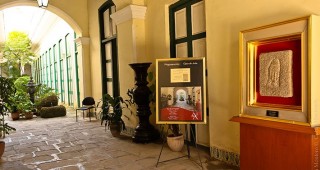The building of the railway station, expression of the Spanish plateresque style, was built in 1912 on the site of the former Armory. It has four floors with 77 windows and the main entrance is rounded off by two slender towers, whose terracotta and tile ornamentation includes the coats of arms of both the city and the nation. It used red Spanish slates for the roofs and a huge clock was featured in the center of the façade. The ground floor, which was used as waiting room, exhibits columns faced with marble. The trains entered the terminal by way of a viaduct of over one kilometer long, which has been known since as “Los Elevados” [The Elevated].

Calle 23 LH  3
3
Calle 23, or 23rd Steet, is a central, busy street in El Vedado district. It begins at the sea and ends in a river, the Almendares. Its first five streets, from Malecón to L Street are known as La Ram …

Casa del Capitán Gaspar Rivero de Vasconcelos LH  3
3
On the corner of Obrapía and San Ignacio Streets, one block west of Mercaderes, stands one of the oldest and best preserved homes in Havana, and despite its relatively simplicity, one of its most stri …
 ColonialAdmission: FreeObrapía #172, Habana Vieja
ColonialAdmission: FreeObrapía #172, Habana Vieja 
Museo de Arqueología (Casa de Juana Carvajal) LH  3
3
Housed in the Casa de Juana Carvajal, this museum is the result of archaeological studies in the Historic Center and the preservation efforts made by the City Historian’s Office. Inside is a fascinati …
 ColonialAdmission: CUC 1Open: 9am-4:30pm Tues-SunCuba #12 e/ O’Reilly y Empedrado, Habana Vieja
ColonialAdmission: CUC 1Open: 9am-4:30pm Tues-SunCuba #12 e/ O’Reilly y Empedrado, Habana Vieja 
Hotel Habana Libre LH  3
3
Located on the famous corner of 23 and L streets, the Habana Libre Hotel, with its 25 floors and 630 spacious rooms, stands majestically and offers an incomparable view of the bay. The building occupi …
 ModernL entre 23 y 25
ModernL entre 23 y 25 
Convento e Iglesia del Carmen LH  3
3
In 1923, members of the order of the Carmelites purchased a lot on the corner of Avenida del Presidente Menocal and Neptuno, where first they created a provisional chapel and later erected the majesti …
 EclecticOpen: Lauds: 8am; Vespers: 6:30pmInfanta entre Neptuno y Concordia
EclecticOpen: Lauds: 8am; Vespers: 6:30pmInfanta entre Neptuno y Concordia 
Coche Mambí LH  3
3
Outside the Museo Palacio de Gobierno sits a railway carriage, still on rails at the corner of Callejón Churruca. It originally belonged to the Cuban Railroad Company and beginning in 1902 was used by …

Museo Nacional de la Danza LH  3
3
Opened in October, 1998, to coincide with the 50th anniversary of the National Ballet of Cuba, this museum features objects mainly from Alicia Alonso’s collection, as well as documentaries, costumes a …

El Torreón LH  3
3
Recently restored, El Torreón or as locals call it Castillito (literally, small castle), built in 1649 with blocks from the San Lázaro Quarry (where José Martí was sentenced to forced labor), was part …

Casa de Asia LH  2
2
Opened in 1997, this small museum—upstairs in a townhouse mansion built in 1688—displays collections that depict the lifestyle, dress, religious beliefs, rituals and traditions from different Asiatic …

Parque de los Mártires Universitarios LH  2
2
This cement park was built in 1967 to honor university students involved in Cuba’s independence struggles. The most notable element, located by the most important entrance, can be interpreted a fist, …



